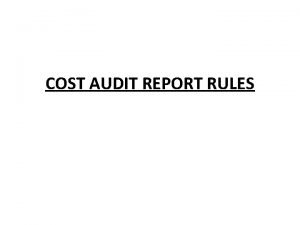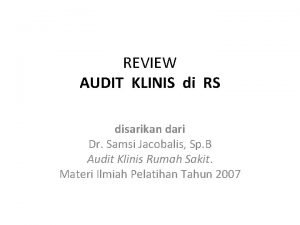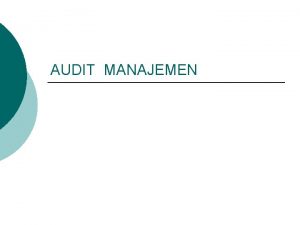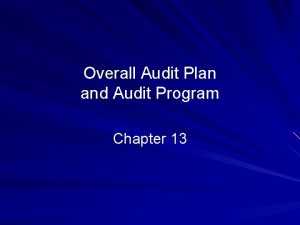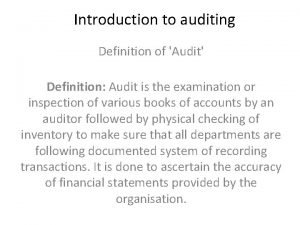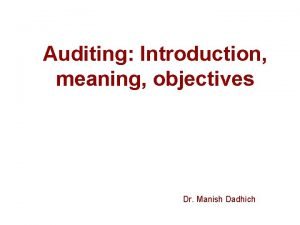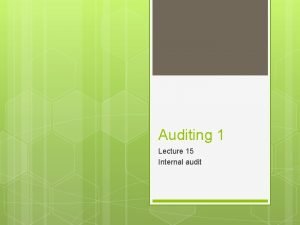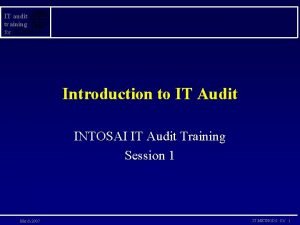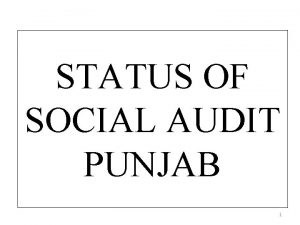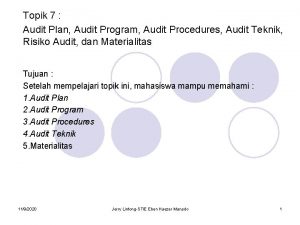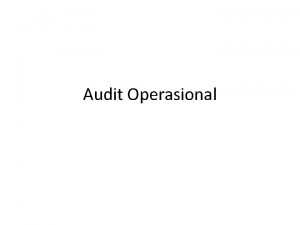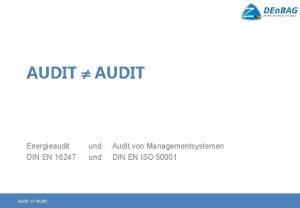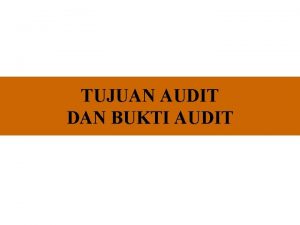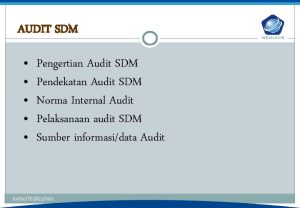Social Audit Contents Introduction What is Social Audit





















- Slides: 21

Social Audit

Contents Introduction What is Social Audit Features Need Objectives Benefits Approach Principles Process Implementation Hindrances Measures Social audit of Indian companies

Introduction Ø Social Audit refers to a process for measuring, understanding and improving the social performance of an activity of the organization. It also measures and reports the social performance in order to achieve improvement and suggest course correction. It is also an independent evaluation of the performance of an organization and an instrument to measure social accountability. Social Auditing enables an organization to assess and demonstrate its social, economic and environmental benefits. It is a way of measuring and evaluating the extent to which an organization or an entity has lived up to the agreed common social objectives. Ø The CSR Act, 2013 mandated Companies to undertake the programs on a project mode in accordance with its approved CSR policy, Social Audit becomes even more prominent to track and report the progress. Therefore, every corporate company has to evolve mechanisms to track and report the progress of social development programs mentioned under Schedule VII of the Act.

What is Social Audit Ø The process of evaluating a firm's various operating procedures, code of conduct, and other factors to determine its effect on a society. The goal is to identify what, if any, actions of the firm have impacted the society in some way. A social audit may be initiated by a firm that is seeking to improve its cohesiveness or improve its image within the society. If the results are positive, they may be released to the public Ø For example, if a factory is believed to have a negative impact, the company may have a social audit conducted to identify actions that actually benefit the society

Need Increasing awareness of society about corporate Social contributions Providing means for identifying and rewarding business for social contributions Improving the credibility and reputation of business Identifying adverse effects on environment Monitoring unethical practices Evaluating performance Social consciousness

Objectives Broad Objectives Creating awareness among beneficiaries and providers of local social and productive services Assessing the physical and financial gaps between needs and resources available for local development Increasing efficiency and effectiveness of local development programmes Estimation of the opportunity cost for stakeholders of not getting timely access to public services Scrutiny of various policy decisions keeping in view stakeholder interest and priorities particularly of rural poor.

Principal objectives Ø The payment of fair and regular dividend to the shareholders Ø The payment of fair wages to workers Ø The reduction of prices to consumers Secondary objectives Ø Provision of bonus to workers Ø Assisting in developing the industry in which firm is a member Ø Promote education , research and development in techniques of industry.

Benefits Social audit provides information for effective response to external claimants that make demands from organisation It supplies data for comparison of policies and standards It encourages greater concern for social performance throughout the organisation It provides data for comparing effectiveness of different types of social welfare programmes It helps the organisation to build up the image and reputation of the organisation in minds of public Social audit enables the company to introspect itself and understand how far it has achieved its social objectives Reduction of wastage Reduction in corruption Awareness among people Promotes collective decision making and sharing responsibilities

Approaches To Social Audit The inventory approach under which a list of all the company’s social activities is prepared The cost or outlay approach in which the amount spent on each activity is disclosed The programme management approach in which in addition to above approaches a statement is made as to whether or not the company has met it’s objectives for each activity The cost benefit approach in which the benefits of each expenditure i. e. the real worth, is indicated.

Principles Ø Multi- perspective - Social Audit should aim to reflect the views of all those people involved with or affected by the organisation Ø Comprehensive –The process should be designed to collect all the relevant materials and reports on all aspects of the organisation’s work and performance Ø Participatory – The social audit programme should encourage participation of stakeholders and sharing of their values Ø Regular - To facilitate comparability and to demonstrate a commitment to the process , it should be regular with a frequency of once every two years

Verification- The social audit process should ensure that the social accounts are audited by a suitable experienced person or agency with no vested interest in the organisation Disclosure – The results of the audit should be published so that the stakeholders can see the results Improved Social Performance – The principle refers to the continuous improvement in performance by the organisation relative to the chosen social objectives as the result of social audit Improvement- It is important to receive feedback about the process and to improve the system over time Embeddedness – The social audit process should be integrated with other business information gathering system.


Process Defining objectives- The first step in implementing a social audit is clear definition of objectives. One should identify the relevant agencies or projects that will be subjected to audit. The implementing agency should also define the time frame for the audit and the specific elements that will be audited Identifying stakeholders- After defining the objectives the next step is to identify the stakeholders. Stakeholders should be a mix of government actors, service providers, project beneficiaries. The stakeholders are perceived as impartial by all the groups involved in the process Collecting and analysing data-The next step is gathering of information. Combination of different methods like interview, survey , quality tests , evaluating panels and participant observation are used to collect data. Organisations also focus on gathering official records and extracting information from the existing data sources. To make this process less time intensive audit committees can be made responsible for interviewing representatives and visiting project sites

Ø Disseminating information- After collecting the data the findings from the audit are provided to the stakeholders for their feedback. This information exchange provides an opportunity for publicising social audit. Some social audit initiatives have used creative media like songs and street plays to explain the process Ø Public hearing – The fifth step if social audit process includes public hearing. A public hearing is open to all citizens and is usually conducted in presence of concerned authorities and stakeholders organisations. It is usually facilitated by a neutral organisation. The public officials are given opportunity to justify their performance. Ø Follow up and reporting – A final social audit report is written up, recommending solutions to the problems. This report should include recommendations for the government regarding actions to address instances of corruption and mismanagement


Implementation Ø Empowerment of people: Social audit is most effective when the actual beneficiaries of an activity are involved in it. The people can only get involved in the process when they are given appropriate authority and rights Ø Proper documentation- Documents that should be mandatory are Application, tenders and proposals , Financial statements, Registers of workers, Inspection reports Ø Accessibility of documents- Generating documents is useless if they are not easily accessible. All the documents must be properly arranged so that they are easily accessible when required Ø Punishable action- unless there is a legal punishment there will be no incentive for the people in authority to implement the process in a fair manner

Hindrances Ø Minds of people: that they are being rude by the politicians, while mindset of politicians that they are the rulers. Due to which common people don’t get involved in the development activities Ø Lack of education among common masses : Since common people are not that educated they do not know their rights Ø Problem of differences in work culture Ø Lack of people participation Ø Timely meetings are not held Ø No follow up procedures Ø Untimely transfer of functionaries makes it difficult to have appropriate responsibility fixation

Measures for Effective Social Audit Process Committed and continued leadership: Strong and committed political and bureaucratic leadership is necessary condition for effective institutionalisation of social audits in a state. Led by a bureaucrat: Social audit by its very nature is a process that naturally creates friction between auditors and bureaucrats. A bureaucrat implementing social audit helps in building trust confidence and credibility Complete and accurate record keeping : Several documents from measurement books to sanction letters are required. The information needs to be made available in a manner that is understandable and easy to verify, records needed to be maintained such that they can be provided to social auditors Clearly defined social audit non negotiable : The non negotiable of social audit must be clearly laid down at the beginning of social audit process and steps must be taken to monitor the audit to ensure that the rules are compiled with.

Social performances by India companies Tata Group conglomerate in India carries out various CSR projects, most of which are community improvement and poverty alleviation programs. Through self-help groups, it is engaged in women empowerment activities, income generation, rural community development, and other social welfare programs. The group also engages in healthcare projects such as facilitation of child education, immunization and creation of awareness of AIDS.

Ultratech Cement Ultratech Cement, India’s biggest cement company is involved in social work across 407 villages in the country aiming to create sustainability and selfreliance. Its CSR activities focus on healthcare and family welfare programs, education, infrastructure, environment, social welfare, and sustainable livelihood. .

Mahindra & Mahindra Indian automobile manufacturer Mahindra & Mahindra (M&M)The company primarily focuses on education programs to assist economically and socially disadvantaged communities. CSR programs invest in scholarships and grants, livelihood training, healthcare for remote areas, water conservation, and disaster relief programs. M&M runs programs such as Nanhi Kali focusing on girl education, Mahindra Pride Schools for industrial training, and Lifeline Express for healthcare services in remote areas.
 Cost audit report
Cost audit report Contents of audit planning memorandum
Contents of audit planning memorandum Contents of audit planning memorandum
Contents of audit planning memorandum Contents introduction
Contents introduction Perbedaan audit konvensional dengan audit berbasis risiko
Perbedaan audit konvensional dengan audit berbasis risiko Perbedaan audit medis dan audit klinis
Perbedaan audit medis dan audit klinis Beda audit medis dan audit klinis
Beda audit medis dan audit klinis Penyelesaian audit dan tanggung jawab pasca audit
Penyelesaian audit dan tanggung jawab pasca audit Kerangka kerja audit manajemen
Kerangka kerja audit manajemen Prosedur audit bottom-up dan audit top-down!
Prosedur audit bottom-up dan audit top-down! Define auditing
Define auditing Perbedaan audit konvensional dengan audit berbasis risiko
Perbedaan audit konvensional dengan audit berbasis risiko The term audit is originated from a latin word
The term audit is originated from a latin word Audit universe adalah
Audit universe adalah Overall audit plan and audit program
Overall audit plan and audit program Social thinking adalah
Social thinking adalah Social thinking social influence social relations
Social thinking social influence social relations Introduction to auditing
Introduction to auditing Introduction to audit
Introduction to audit Introduction to audit
Introduction to audit Introduction audit interne
Introduction audit interne Introduction to it audit
Introduction to it audit
